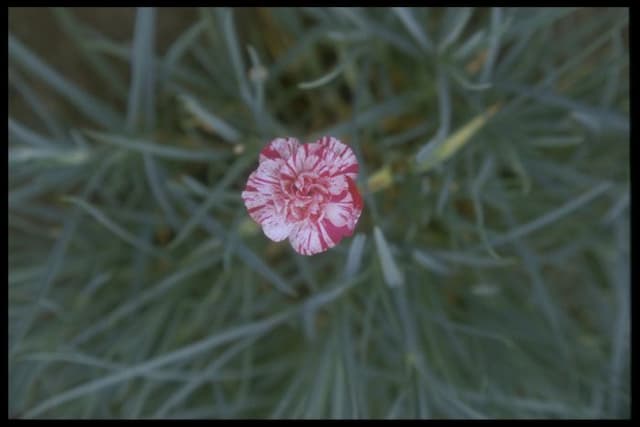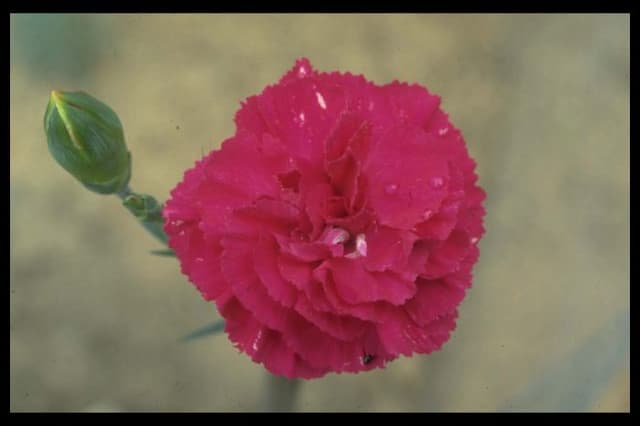Carnation Dianthus 'Gran's Favourite' (p)

ABOUT
Dianthus 'Gran's Favourite' is a charming plant known for its eye-catching and pleasantly fragrant flowers. This variety, often referred to as a carnation or pinks, sports unique blooms that exhibit a classic, romantic appeal. The flowers are highly distinctive with their frilly, serrated petal edges that often resemble a finely cut lace. Each petal traditionally has a combination of white and purplish-pink shades, creating a delightful two-toned effect, with the pink forming a striking contrast against the white base color. The petals generally have a remarkable pattern, with splashes or flecks of deep plum to raspberry pink, which bleed into the softer white ground. In some blooms, these markings may appear as neat concentric rings or as irregular splotches, evocative of an artist dabbing paint with a brush. At the center of the flower, the reproductive parts, consisting of a cluster of stamens and a stigma, often add a subtle touch of yellow or green, blending seamlessly with the more vivid petal colors. The foliage of 'Gran's Favourite' is also noteworthy, forming a tidy clump of slender leaves. The leaves are typically blue-green to grey-green in color and have a linear to lanceolate shape with a smooth or slightly rough texture. These slim leaves combine to create a dense tufted mound, which serves as an elegant backdrop to the striking flowers perched atop slender stems that rise just above the foliage. In summary, the overall appearance of Dianthus 'Gran's Favourite' exudes a quaint cottage charm, distinguished by its gorgeously patterned, lacy flowers set against an attractive, neat clump of slender foliage, making it a beloved choice for ornamental gardens and borders.
About this plant
 Names
NamesFamily
Caryophyllaceae
Synonyms
Gran's Favourite Pinks, Gran's Favourite Carnation, Gran's Favourite Dianthus
Common names
Dianthus 'Gran's Favourite'
 Toxicity
ToxicityTo humans
Carnations are not considered highly toxic to humans. However, eating large amounts of any plant material could lead to gastrointestinal discomfort, including mild nausea, vomiting, or diarrhea. Generally, touching or handling the flowers is unlikely to cause any significant reaction unless an individual has a specific allergy or sensitivity. Always practice caution and keep plants out of the reach of small children who may be tempted to chew on them.
To pets
Carnations contain substances that can be mildly toxic to pets, particularly cats and dogs. If ingested, they may cause mild gastrointestinal symptoms including drooling, vomiting, and diarrhea. These effects are usually self-limiting, and most animals recover without needing major medical treatment. Nevertheless, it is a good practice to keep carnations and other ornamental plants out of the reach of curious pets to prevent any potential health issues.
 Characteristics
CharacteristicsLife cycle
Perennials
Foliage type
Evergreen
Color of leaves
Green
Flower color
White
Height
1 foot 6 inches (46 cm)
Spread
1 foot (30 cm)
Plant type
Herb
Hardiness zones
3
Native area
Europe
Benefits
 General Benefits
General Benefits- Aesthetic Appeal: Dianthus 'Gran's Favourite' has a unique bi-color pattern, with fringed edges and a lovely clove scent that can enhance the beauty of any garden.
- Attracts Pollinators: This variety of dianthus attracts bees and butterflies, which are essential for pollinating plants in your garden.
- Long Blooming Period: Dianthus 'Gran's Favourite' has a lengthy flowering season, often from late spring to early fall, providing continuous color in the landscape.
- Drought Resistance: Once established, it is relatively drought-resistant, making it suitable for low-water gardens.
- Easy to Grow: This plant is known for being low-maintenance and easy to grow, perfect for new gardeners or those who prefer minimal gardening efforts.
- Versatility: The plant can be used in various garden settings, including borders, rockeries, and containers, or as ground cover.
- Cold Tolerance: Dianthus is capable of withstanding cooler temperatures and can survive light frosts, making it suitable for a range of climates.
- Deer Resistance: It is less appealing to deer compared to other garden plants, thereby reducing the risk of damage from wildlife.
- Cut Flower Usage: The blossoms of Dianthus 'Gran's Favourite' make excellent cut flowers for bouquets due to their fragrance and long vase life.
- Minimal Pest Issues: It is generally resistant to many common pests that afflict other garden plants.
 Medical Properties
Medical PropertiesThis plant is not used for medical purposes.
 Air-purifying Qualities
Air-purifying QualitiesThis plant is not specifically known for air purifying qualities.
 Other Uses
Other Uses- Dianthus 'Gran's Favourite' flowers can be pressed and used in artistic crafts, such as creating unique designs for homemade greeting cards or bookmarks.
- The carnation petals can be crystallized with egg whites and sugar to be used as edible decorations for cakes and desserts.
- They can be used in potpourri mixtures for their fragrance and color, providing a natural way to freshen up a room.
- The flowers of the carnation can serve as indicators for pH levels in a science experiment, changing color in response to acidic or basic solutions.
- Dried Dianthus petals can be used to make natural dyes for fabric, offering a range of pink hues depending on the mordant used.
- Carnations can be incorporated into homemade floral waters or perfumes due to their strong, distinctive scent.
- Carnation petals can serve as a natural confetti for outdoor celebrations, being biodegradable and more environmentally friendly than plastic alternatives.
- Dried Dianthus 'Gran's Favourite' flowers can be used in burner sachets to infuse a room with their fragrance when gently warmed.
- The vivid colors of carnations can be captured in ice cubes to add an elegant touch to drinks during summer garden parties.
- Their sturdy structure allows carnations to be used in living jewelry, such as corsages and boutonnieres, retaining their shape and freshness.
Interesting Facts
 Feng Shui
Feng ShuiCarnation is not used in Feng Shui practice.
 Zodiac Sign Compitability
Zodiac Sign CompitabilityCarnation is not used in astrology practice.
 Plant Symbolism
Plant Symbolism- Devotion: Carnations, like the 'Gran's Favourite', often symbolize deep love and devotion, reflecting a bond that lasts through time.
- Admiration: The flower is known to convey admiration, making it a popular gift to show respect and fascination with someone's grace.
- Distinguishment: The unique pattern of 'Gran's Favourite', with its pink and white hues, represents the wearer's distinctive and remarkable character.
- Pure Love: White carnations are associated with pure love and good luck, which could extend to this variety due to its coloration.
- Motherly Love: Particularly due to its common name referencing a 'Gran,' it may be seen as a symbol of a grandmother's undying love.
- Remembrance: Carnations are often used to honor loved ones and are thus associated with remembrance and the immortality of a cherished memory.
 Water
WaterPinks, including Dianthus 'Gran's Favourite', should be watered thoroughly when the top inch of the soil feels dry to the touch, typically about once a week. Deep watering encourages the roots to grow downwards, searching for moisture and thus strengthening the plant. During the growing season, an approximate guide would be to provide one gallon of water per square foot every week. However, this may vary depending on climate conditions and soil type. In hot, dry weather, more frequent watering may be necessary, while in cooler or rainy periods, you can water less often. Always take care to avoid watering the foliage directly to prevent fungal diseases.
 Light
LightPinks thrive in full sun conditions, so Dianthus 'Gran's Favourite' should be placed in a location where it can receive at least six hours of direct sunlight daily. This plant will perform best when it has plenty of light to promote healthy growth and flowering. Avoid deep shade areas as this can lead to poor blooming and a leggy plant.
 Temperature
TemperaturePinks prefer moderate to cool temperatures and can generally tolerate a range between 40°F to 85°F. Dianthus 'Gran's Favourite' thrives in the ideal temperature range of 60°F to 70°F. They are also quite cold hardy and can survive short periods of frost, although prolonged exposure to temperatures below freezing may damage the plant.
 Pruning
PruningPinks should be pruned to promote vigorous growth and to maintain their compact shape. Deadhead Dianthus 'Gran's Favourite' regularly to encourage more blooms and prevent the plant from self-sowing excessively. Cut back the foliage by one-third after the first flush of flowers is over to stimulate a second bloom. The best time for major pruning is in early spring.
 Cleaning
CleaningAs needed
 Soil
SoilCarnations prefer well-draining soil with a slightly alkaline pH of 6.7 to 7.0. A mix of loam, peat moss, and perlite or sand can create an ideal growing medium for Dianthus 'Gran's Favourite'.
 Repotting
RepottingCarnations should be repotted every 2 to 3 years or when they outgrow their current container, ensuring fresh soil and space for continued growth.
 Humidity & Misting
Humidity & MistingCarnations thrive in moderate humidity levels but can tolerate a range from low to high, provided they have good air circulation to prevent disease.
 Suitable locations
Suitable locationsIndoor
Place Carnations in bright indirect light with good airflow indoors.
Outdoor
In the garden, plant Carnations in full sun with well-drained soil.
Hardiness zone
3-9 USDA
 Life cycle
Life cycleDianthus 'Gran's Favourite', commonly known as "Gran's Favorite," begins its life as a seed which, when planted in well-draining soil and given sufficient warmth and light, germinates to produce small seedlings. As these seedlings grow, they develop into a rosette of blue-green leaves, with the plant eventually forming a sturdy stem supporting a proliferation of flowering stalks. The full bloom stage occurs in late spring to early summer, during which the plant showcases its ruffled, bi-colored flowers with a distinctive spicy fragrance. After flowering, if pollinated, the plant may set seed, which can be collected and sown to propagate new plants. Over time, the plant will enter a period of dormancy, especially in cooler climates, where it may die back slightly before resurging in the following growing season. With proper care, including regular deadheading and division to prevent overcrowding, Dianthus 'Gran's Favourite' can live for several years, behaving as a short-lived perennial.
 Propogation
PropogationPropogation time
Spring-Early Summer
Propogation: The Dianthus 'Gran's Favourite', commonly known as pinks, is typically propagated through softwood cuttings. The best time to propagate pinks through cuttings is in late spring or early summer when the plant is actively growing. To do this, a gardener would cut a piece of the stem that has a few sets of leaves, ideally about 3 to 5 inches (7.6 to 12.7 centimeters) long. The lower leaves should be removed and the cut end dipped in rooting hormone before being placed in a well-draining soil mix. The cutting should then be kept in a warm, humid environment, out of direct sunlight until roots develop, which generally takes a few weeks. Once rooted, the cuttings can be planted out in their final location.









